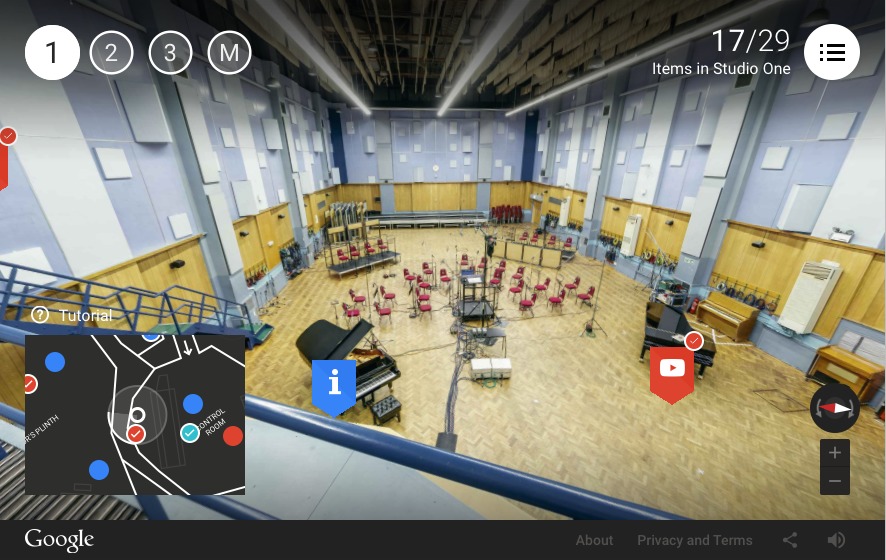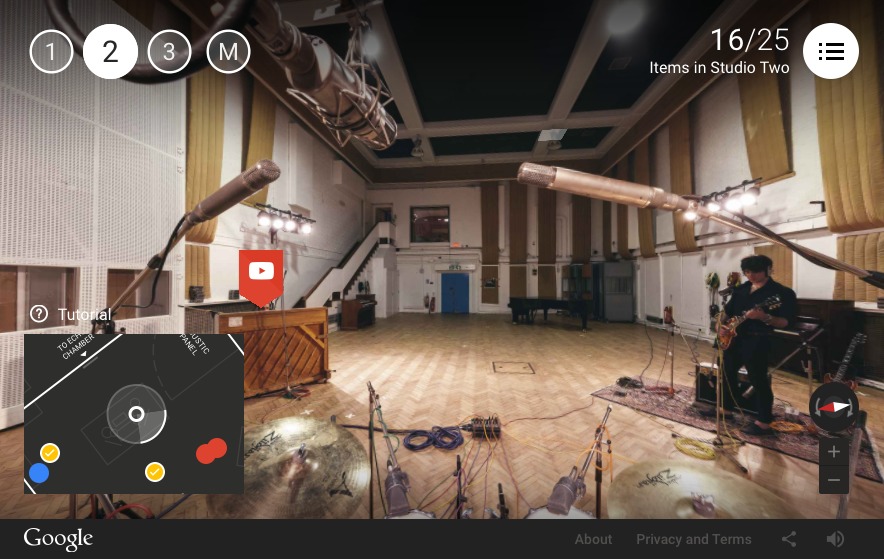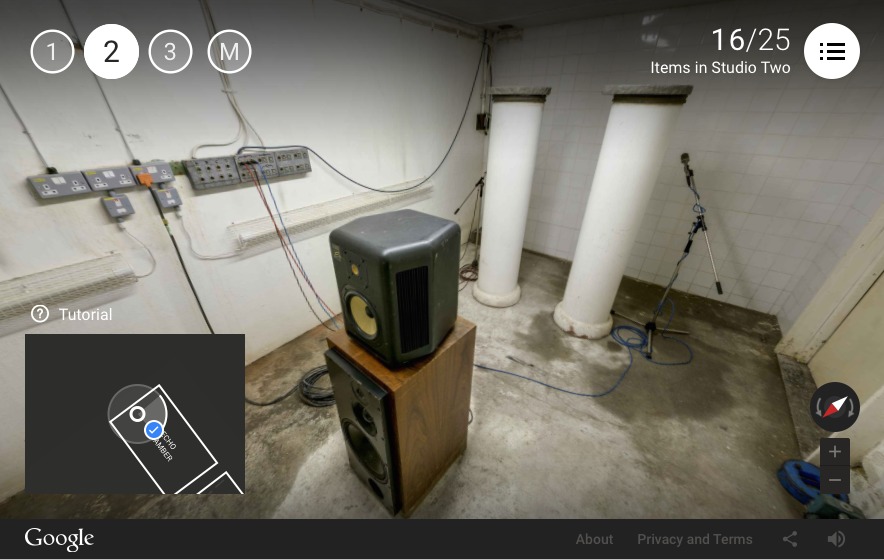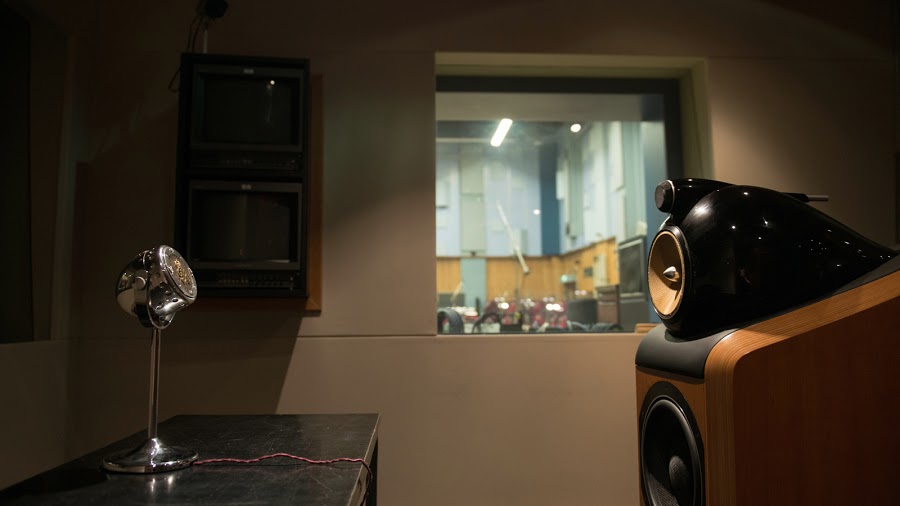FunBITS: Google Takes You to Abbey Road
[For Geoff’s awesome music-enhanced audio version of this article, click the Listen link in the metadata line at the top of the article’s Web page. -Adam]
In music, the phrase “in the studio” has always carried a certain cachet with both performers and listeners, and perhaps no studio in the world is better known than Abbey Road Studios in London, opened in 1931 and famously where, in the 1960s, The Beatles and producer George Martin largely redefined popular music. Now, Google has devoted some of its engineering and Web expertise to create Inside Abbey Road, an online, interactive tour of Abbey Road Studios that enables users to virtually walk through the studio’s rooms, history, and technology — and check out famous recordings made there, from the classic albums of The Beatles and Pink
Floyd to well-known movie soundtracks and the work of more-contemporary artists like Oasis, Florence and The Machine, and Sam Smith.
Virtual walk-throughs and guided tours aren’t new — after all, games have been doing essentially the same thing for decades. But Google has built Inside Abbey Road using only Web technologies available in modern browsers — HTML5, CSS, panoramic imaging, Web Audio, and WebGL — to handle navigation, high-resolution panoramas, ambient audio, seamlessly integrated video, and interactive gadgets. Even a few years ago, this project would have been unthinkable without Adobe Flash — and now it works on tablets and even phones, as well as traditional notebook and desktop computers.
Is Google’s effort worth your time? If you have any curiosity about how a world-class recording facility works — or just enjoy the tremendous range of artists that have recorded at Abbey Road over the years — then the answer is yes.
About Abbey Road — The building where Abbey Road Studios is located was built in the 1830s as a large townhouse; eventually, it was converted to apartments (“flats,” in British English) and in 1931 the Gramophone Company bought the somewhat-dilapidated property and converted it to recording spaces. Abbey Road currently has three primary studios, aptly named Studio One, Studio Two, and Studio Three. In the 1930s the Gramophone Company (you might remember their “His Master’s Voice” label) was primarily concerned with recording classical music, so Studio One was designed to simultaneously handle a
very large orchestra and a small audience, making it both a recording and performance space (an idea that’s more or less continuous in Abbey Road’s history, as we’ll see). Studio One can lay claim to being the world’s largest purpose-built recording studio: while plenty of recordings get made in larger places, those were typically built as concert halls, chapels, and theaters, not dedicated recording facilities. If you’re a Reader of a Certain Age, you’ve seen Studio One: The Beatles’s portion of the 1967 “Our World” live satellite program (featuring “All You Need is Love”) was broadcast from Studio One and viewed live by over
400 million people.
The smaller Studio Two (and, to a lesser extent, Studio Three) are at the heart of British rock and pop music, with Abbey Road rock-and-roll first getting on the charts with Cliff Richard in the late 1950s and truly emerging with The Beatles, who recorded almost all their albums in Studio Two with producer George Martin. I use the word “smaller” in a relative sense: I’ve worked in recording studios since my teens, and few are as large as Abbey Road’s Studio Two or Studio Three.
As a physical room, Studio Two is much the same as when The Beatles recorded there, complete with tall wheeled baffles used to change the shape of the space, and the deliberately-out-of-tune tack piano, named for the once popular but now mostly forgotten sing-along performer Gladys Mills. You’ve probably heard it: Paul McCartney used the piano on “Lady Madonna” and other Beatles tracks.
Studio Three — where Pink Floyd famously didn’t recognize former frontman Syd Barrett while recording “Shine on You Crazy Diamond” — has been updated to a more contemporary space, complete with Abbey Road’s famous mirrored drum room straight out of the 1980s. (One way to make drums sound bigger is to record them in a very “live” room where almost every surface reflects sound.)
Google’s tour of Abbey Road also highlights a mastering suite, where recordings are equalized, processed, and prepared for distribution, whether that’s directly to digital services or cutting on a vinyl lathe. Yes, Abbey Road will still make proper “records” if clients ask — and one of the studio’s neatest artifacts is a stereo cutting head developed by Alan Blumlein in the 1930s, decades before stereo become a standard for phonograph recordings. It still works.
Getting Around — If you’ve used Google Street View, you can navigate Google’s tour of Abbey Road. Users can get a real sense of the studios’ physical space, go up and down Studio Two’s famous stairs, and explore the corners; plus, audio geeks can zoom in on racks of equipment to read all the labels. (For fun, find all the silver Mac Pro towers — they’re visible in every control room.) Google says the site is best experienced with headphones, and that’s because they really want you to notice the ambient noises: for instance, as you walk past the large isolation booth off Studio One, the sound of a harpist warming up in there shifts from left to right (and
even forward and back) as you pan around. It’s legitimately fun.
Every location on the tour is festooned with hotspots linking to more-detailed information or to videos and pictures of the tremendous variety of artists associated with Abbey Road. Some highlights include Abbey Road’s echo chamber (it’s a real room, not an electronic effect!), details of the studio’s prized microphone collection, and features on film scoring, the role of producers, and even Studio One’s squeakless chairs for orchestra players. Most of the video is direct from YouTube or Vevo.
However, perhaps the most accessible features are three guided tours, voiced by producer Giles Martin (who happens to be George Martin’s son), Abbey Road’s head of audio products Mirek Stiles, and Lauren Laverne, perhaps best known as a host (“presenter” in Britain) on BBC Radio 6 Music. Each tour covers a different portion of Abbey Road, with Martin covering the recording process, Stiles discussing some of the technology and notable work at Abbey Road, and Laverne highlighting personalities and behind-the-scenes moments.
The tours are self-paced (so you can look around as much as you like anywhere along the way), and reflect the sound of each space. Google and Abbey Road cheated a bit here: each host was recorded separately, then the recordings played back on a speaker in each room to capture a bit of each space’s sound. It’s a common technique: Abbey Road did the same thing to re-record Colin Firth’s voice through their EMI PM 201 dynamic mic for the film “The King’s Speech,” as it’s the same microphone King George VI used when declaring war on Germany in 1939.
The site also offers a handful of “gadgets” that enable visitors to try their hand at mixing audio tracks, creating old-school tape effects, and mixing down four-track recordings — just like The Beatles had to do! Another gadget offers panoramas of microphones so rare and costly most people will never see them any other way.
Let me spill a little bit of TidBITS history here: while I essentially grew up doing music and audio, Adam and Tonya have little musical background — other than truly enjoying music. Ages ago, a few of us went to Seattle’s EMP Museum, which features interactive exhibits where visitors with no musical experience can try their hand with real instruments, mixing boards, and even turntables. (For the record: Tonya was rocking the bass line to “Wild Thing” in about a minute, but Adam made for a hopeless drummer.) The EMP experience highlighted for me how difficult it is to make this stuff accessible for everyday folks. It wasn’t just Adam and Tonya who didn’t become instant
rock stars: almost everybody was struggling.
So, I had very low expectations for the Inside Abbey Road gadgets, but I was pleasantly surprised. While they aren’t particularly intuitive, they do capture and illustrate the key concepts, and the gadget emulating a J37 four-track tape recorder is just a ton of fun, even if it’s a skill that literally no one needs anymore. My only objection is that the gadgets are a bit game-ified: users can compare their results to a preset goal, which might discourage folks with no experience, since their first scores are probably going to be abysmal. I’m also impressed Google was able to pull this off without resorting to Flash or other browser plug-ins. Web audio has come a long way.
What’s Not To Like? — The way Google presents the Inside Abbey Road project is a bit weird. Some of the technology ideas come from the Google Cultural Institute, which attempts to make significant cultural institutions, historical events, and natural wonders virtually accessible to anyone in the world with a decent Internet connection. And, given the resemblance, one might think the Inside Abbey Road site was akin to Google’s virtual tours of Pompeii, the Bolshoi Theater, or South Africa’s Robben Island.
It’s not. Although the British government recently made Abbey Road Studios a listed site (along with its famous crosswalk — that’s a “zebra crossing” in the UK), Abbey Road Studios is not a non-profit cultural institution. Abbey Road is a high-profile commercial operation, now owned by Universal Music Group, in a highly competitive industry. Google’s Inside Abbey Road essentially amounts to a huge, highly interactive advertisement for Abbey Road Studios, Universal, and many of the artists associated with them, and it sure doesn’t take long to be presented with links to buy music via Google Play. (But not The Beatles! They’re still an iTunes exclusive.) There are hundreds, if not thousands, of recording studios
around the world who’d love this kind of exposure.
And Abbey Road very much wants to promote itself. Although its doors have been open over 80 years, Abbey Road’s survival has never been guaranteed. For instance, despite being purpose-built, Studio One wasn’t tremendously well regarded for classical music: its reverb time was pretty short, leading Abbey Road to experiment somewhat desperately with “ambiophany” — using about 100 loudspeakers to augment the studio’s reverb. That didn’t really work out, and as the market for classical music waned Abbey Road considered dividing Studio One into smaller spaces. They were able to save Studio One through a smart (and inexpensive!) acoustic re-treatment by renowned engineer Ken Townsend, and eventually developed a business
recording film and game soundtracks.
The digital music revolution — and associated decline in record company revenues — created lean times for most recording studios, including Abbey Road. Even back in the day, knowledge and a little bit of luck could create world-class recordings without a world-class studio. (For instance, Joe Meek’s work — like the 1959 space-skiffle album “I Hear a New World” — may have been as influential as anything from Abbey Road, but much of it was produced in his flat maybe a mile away.) These days it’s more common to record an album on a laptop in a bedroom than shell out for studio time. And London ain’t cheap: only a few years ago there was serious concern Abbey Road
would be torn down and replaced with condominiums, thanks to the financial troubles of then-owner EMI.
Abbey Road has long been reinforcing the notion that it is itself a brand and cultural institution. Remember when I said the three main studios are both recording and performance spaces? Some of what you don’t see in Google’s tour are the studio’s in-house restaurant, bar, and garden for handling private events. (Google’s tour also omits two smaller studios primarily used for mixing.) Also consider “Live from Abbey Road,” a television show that ran for five seasons (“series,” in British parlance) featuring live, HD performances from Studios One, Two, and Three. Those sorts of live events and filmed sessions are now a big part of Abbey Road’s business. The studio — and its owners — would love to see playing Abbey
Road become as prestigious as playing iconic venues like the Royal Albert Hall, Carnegie Hall, or the Grand Ole Opry… except the performers, not the audiences, would pay to attend.
Does any of this detract from the Inside Abbey Road site? A bit, but if you’ve any interest in how music is made or the countless artists, engineers, and producers whose creative energy has probably touched us all, don’t let it deter you. Abbey Road will probably still be around in a few years, but who knows if this site will be? The Web moves quickly, and — unlike Abbey Road — the Web has little regard for its own history.





When I click on "Listen", I get the message "Video can't be played because the file is corrupt". This is with Firefox 37.0.1
Try this link - https://tidbits.com/podcasts/15648.m4a - there may be an extra 's' at the end the commending system is inserting for some reason, but it looks like the link works. You should be able to download from there directly.
Safari and Chrome seem to handle it just fine. (FYI: Firefox only recently started handing off media like AAC audio to "native" handlers in OS X: it's possible there are still some rough edges.)
Geoff, the link gave the same "corrupt file" message, but the mp4 played fine with QuickTime Player.
I'm sorry: I should have been more explicit: I meant the link as a means to download the file and play it in another app (perhaps QuickTime Player, but the preview feature in the Finder should probably work too: just select the file and press the spacebar). I'm really not sure what's going on with FireFox.
Sorry about that - it looks like Firefox can't handle it. Other browsers should just fine.
My Firefox 37.0.2 on a Mac Pro handled the whole thing just fine, and I enjoyed it. My sons grew up with the Beatles, and now at age 80 I still enjoy them. Thanks for adding this to TidBits.
Safari just freezes with the spinning beachball of death when I just try to go to the article.
Edit: updating to FF 37.0.2 did not make any difference.
Edit 2: Even Firefox 38.0 does not work.
If Safari is crashing, I'd reboot - there's certainly no general issue with Safari loading the article or we'd have heard from hundreds of people. Firefox probably needs some add-on to handle the audio file.
BTDT, No T-shirt
FF has played other mp4s by launching QuickTime Player.
Well, Safari has decided to start working and will play the podcast. However, it gives me an error trying to play the flash item even with the most recent plug-in installed (before it told be to update the plug-in)
Well, Safari has decided to start working and will play the podcast. However, it gives me an error trying to play the flash item even with the most recent plug-in installed (before it told me to update the plug-in)
What Flash item? We're not using any Flash, though it's possible Google AdSense is including some in an ad.
The YouTube video between paragraphs 4 & 5. In Safari, it is a dark gray box with the word "Flash" on it. When I clicked on it the first time, it told me my Flash plug-in (ver 16.x) was outdated. After updating the plug-in to version 17, it now says "An error has occurred. Please try again later."
I found out it was a YT video by checking the link in the plain text copy of TidBITS #1272. BTW, clicking the link in the plain text copy, causes the video to play just fine.
Ah! Thanks for reporting this - I don't think it's really a Flash problem at all. What happened is that the YouTube link we used had a time offset encoded into it, so it would jump to the proper place in the video. (It wasn't working in Chrome either - we just looked to see that it was present, rather than actually clicking to see that it loaded.) That required an ampersand in the URL, and our system encoded the ampersand as an HTML entity, and in the process broke the URL entirely. The text link (under All You Need Is Love) was fine, and I've made it so the video doesn't embed at all now. We'll keep in mind that we can't embed YouTube videos with time offsets without fixing our code first...
Super article Geoff, as an expat brit living in Hong Kong I really enjoyed it especially the "english" translations.
I hope it will encourage people to visit this iconic place, I plan to take my grandson there in the summer.
Glad you enjoyed the article! A British acquaintance is always correcting my "Americanisms"so I figured it was appropriate to do the reverse writing about Abbey Road.